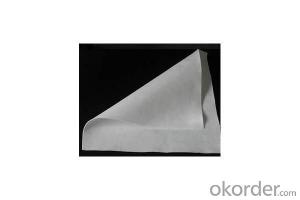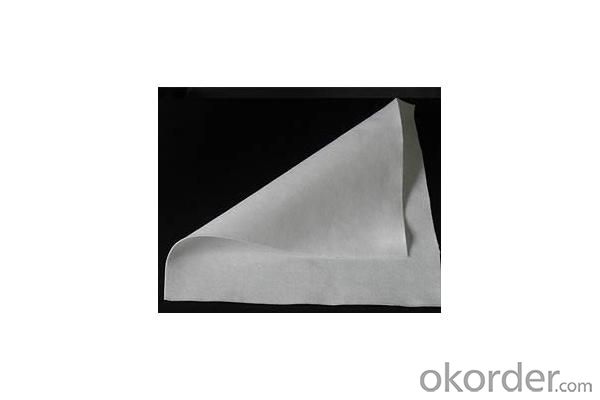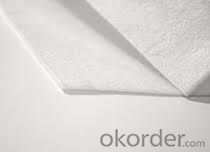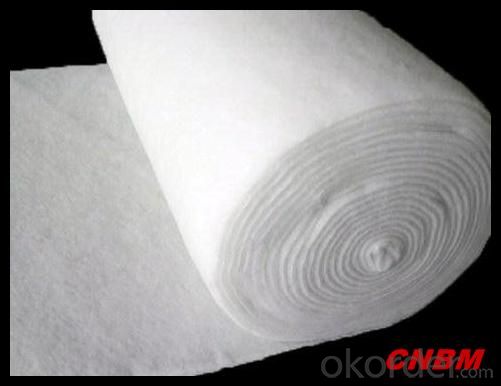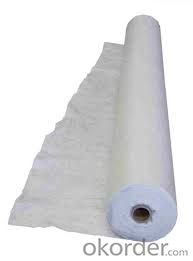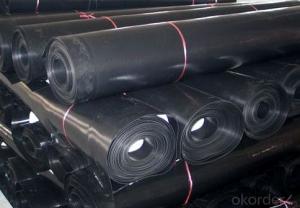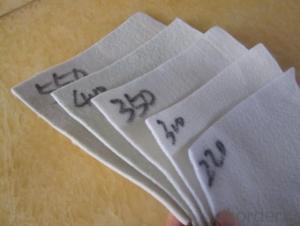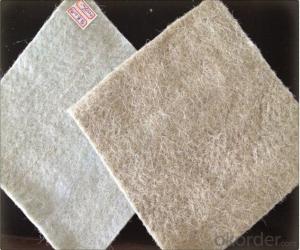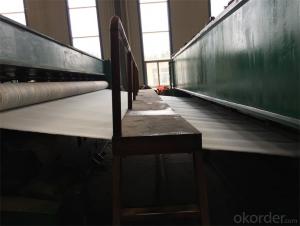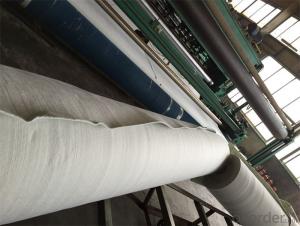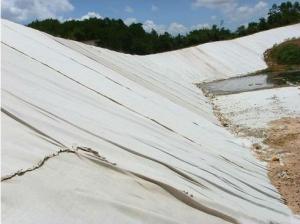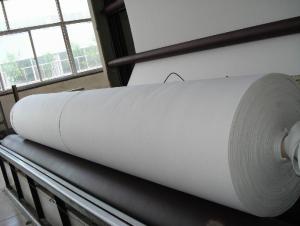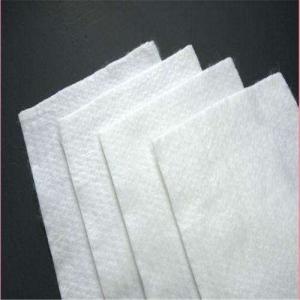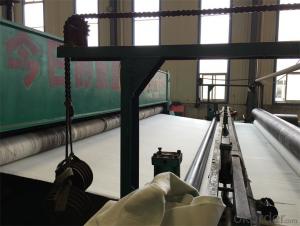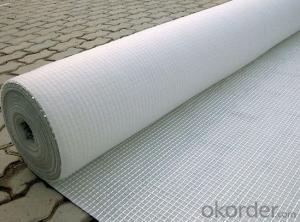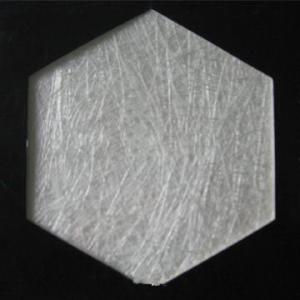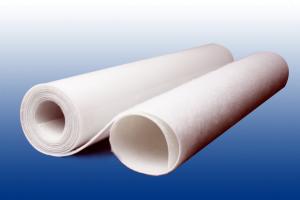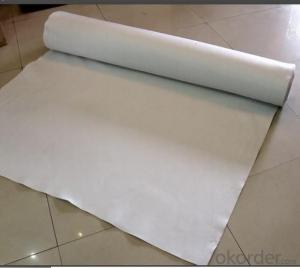Fibertex Geotextile Fabric Road Construction Non-Woven Polyester
- Loading Port:
- China main port
- Payment Terms:
- TT OR LC
- Min Order Qty:
- 1000 m²
- Supply Capability:
- 500000 m²/month
OKorder Service Pledge
OKorder Financial Service
You Might Also Like
Specification
Geotextile fabric road construction non woven polyester geotextile Description:
Made from PP(polypropylene) or PET(polyester) short fiber by nonwoven needle punched
manufacturing process, it has isolation, filtration, drainage, reinforcement, protection and
maintenance etc.function
Geotextile fabric road construction non woven polyester geotextile Specification:
1.80g/m2-1500g/m2
2.1m-8m in roll width, the length as clients’request
·Technical specification of shart fiber needle punched non woven geotextile (GB/T17638-1998)
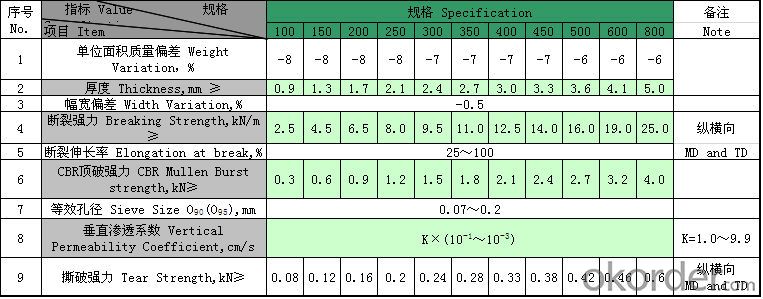
Geotextile fabric road construction non woven polyester geotextile Property:
1.Good flexibility, resistant to corrosion, resistant to acids and alkalis, anti_oxidation
2.Separation, filtration, drainage, reinforcement, protection, and maintenance function
Geotextile fabric road construction non woven polyester geotextile Application:
1.Water conservancy project and hydropower project
2.Road paving, railway
3.Airport and port
4.River bank protection and tunnel
5.Environmental protection,etc
Packaging & Shipping
Packing: PLASTIC FILM INSIDE, AND WOVEN BAG OUTSIDE
Shipping: About 15 days after receipt the deposit
pecifications
geotextile fabric
permeability,filtration,easy for construction
ISO and CE certificate
Good quality and competitive price
Our Service
Quality assurance
1.On a regular basis or as per your request,we entrust national testing agencies to conduct quality inspections
2. Strictly in accordance with the ISO9001-2008 international quality system standard,we monitor and manage the whole process throughout production,quality testing,and measurement to ensure product quality
3. For quality-related construction delay or substandard construction(except for damage or losses due to customer’s responsibility or irresistible natural disasters),we have refunding,replacement,and repair services.We will respond to customers’ feedbacks on quality issues within 24 hours.
After-sales service
1.In order to provide customers with comprehensive technical support,we will provide technical and other related information upon request in a timely manner.
2.In required,we will appoint specialized technicians to the construction site to give technical trainings to construction people,and offer technical guidance throughout the whole construction process.
3.For damage due to shipment and delivery,after we receive the complaint,we will check the issure through provided pictures and videos.If our responsibility is confirmed,we wil offer free replacement.
4.When the construction is completed,as your request,our technical staff may participate in the final acceptance.
FAQ:
Q: What kind of payments does jenor support?
A: T/T, L/C, Cash are accepted.
Q: Do you charge for the samples?
A: Accordeing to our company policy, the samples are free, we only charge the freight fee. And we will return the freight fee during the next order.
Q: Can you produce according to customers' design?
A: Sure, we are professional manufacturer, OEM and ODM are both welcome.
Q: Do you have other products?
A: Yes, please check the pictures:
- Q: How do geotextiles help with soil reinforcement in retaining walls?
- Geotextiles help with soil reinforcement in retaining walls by providing a strong and stable foundation. They act as a barrier between the soil and the wall, preventing erosion and soil movement. The geotextiles distribute the pressure from the soil evenly, increasing the stability and strength of the retaining wall. Additionally, they allow for proper drainage and filtration, reducing the build-up of water pressure behind the wall, which can cause structural failure.
- Q: How are geotextiles made?
- Geotextiles are made by weaving or knitting synthetic fibers together to create a strong, durable fabric that can be used for various geotechnical applications.
- Q: Can geotextiles be used for erosion control in mining sites?
- Yes, geotextiles can be used for erosion control in mining sites. Geotextiles are synthetic materials that are specifically designed to stabilize soil and prevent erosion. They can be used in various applications, including mining sites, to control erosion by providing a barrier between the soil and water or wind. Geotextiles help to reduce sediment runoff, improve soil stability, and protect the environment in mining areas.
- Q: How do geotextiles improve soil stability?
- Geotextiles improve soil stability by providing reinforcement and separation. They prevent soil erosion, retain moisture, and distribute loads, ultimately enhancing the overall strength and stability of the soil.
- Q: What are the factors to consider when designing geotextile-reinforced walls?
- When designing geotextile-reinforced walls, there are several factors that need to be considered. Firstly, the strength and stability of the geotextile material itself is crucial. The geotextile should have sufficient tensile strength and durability to withstand the loads and pressures exerted on the wall. Secondly, the soil characteristics and properties must be thoroughly analyzed. Factors such as soil type, compaction, and shear strength are essential in determining the design of the reinforced wall. The slope of the site and the anticipated slope stability also play a significant role. The angle of inclination and the height of the wall will impact the design and reinforcement requirements. Additionally, proper drainage is vital to prevent water buildup and potential failure of the wall. The design should incorporate adequate measures to ensure effective water management and prevent hydrostatic pressure. Considering the environmental conditions is essential. Factors such as temperature variations, freeze-thaw cycles, and corrosive substances in the soil must be taken into account to ensure the longevity of the geotextile-reinforced wall. Lastly, construction techniques and maintenance requirements should be considered during the design phase. The ease of installation, access for maintenance, and potential future repairs should all be evaluated to ensure the practicality and sustainability of the reinforced wall.
- Q: How do geotextiles help with soil separation in subgrade improvement projects?
- Geotextiles are used in subgrade improvement projects to separate different soil layers, preventing them from mixing. They act as a barrier, allowing water to pass through while preventing the migration of fine particles. This helps to maintain the stability and strength of the subgrade, reducing the risk of settlement and soil erosion.
- Q: Geotextile longitudinal and lateral elongation gap is too much how to adjust
- 1. The elongation at break of the geotextile is divided into longitudinal elongation at break and transverse elongation at break. Generally speaking, the elongation at longitudinal and transverse faults is not very different. GB GB / T-2008 standard requirements geotextile longitudinal and lateral elongation between 20% -100% are qualified. 2. Longitudinal transverse fracture elongation gap is too large, you can check the mixing hopper, carding machine is mixed evenly, combing evenly. 3. Acupuncture machine too fast or too high acupuncture may lead to geotextile longitudinal and transverse elongation gap, you can try to debug the speed of the next needle machine. 4. Appropriate to add some industrial oil can enhance the geotextile rupture strength, and elongation at break.
- Q: Do you have a geotextile bed?
- Well, geotextile material is not environmentally friendly
- Q: Where to sell waterproof geotextile
- Building materials market should have hope to help you
- Q: What are the factors to consider when designing geotextile-reinforced pavements?
- When designing geotextile-reinforced pavements, several factors need to be considered. Firstly, the type and characteristics of the geotextile, such as its tensile strength, permeability, and durability, are crucial for ensuring its effectiveness in reinforcing the pavement. Secondly, the properties of the soil and subgrade, including their bearing capacity, moisture content, and stability, must be taken into account to determine the appropriate geotextile design. Additionally, the traffic load and volume, as well as the climate conditions of the project area, play a significant role in selecting the suitable geotextile and pavement thickness. Proper installation techniques, quality control measures, and regular maintenance should also be considered to ensure the long-term performance of geotextile-reinforced pavements.
Send your message to us
Fibertex Geotextile Fabric Road Construction Non-Woven Polyester
- Loading Port:
- China main port
- Payment Terms:
- TT OR LC
- Min Order Qty:
- 1000 m²
- Supply Capability:
- 500000 m²/month
OKorder Service Pledge
OKorder Financial Service
Similar products
Hot products
Hot Searches
Related keywords
